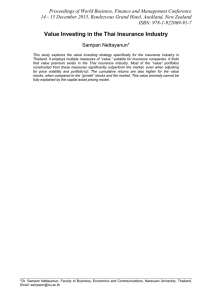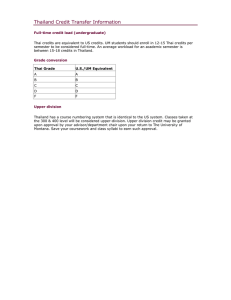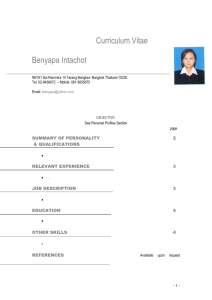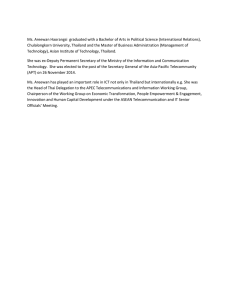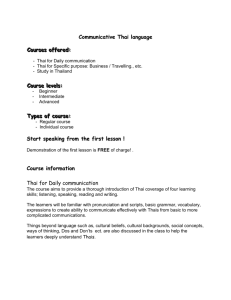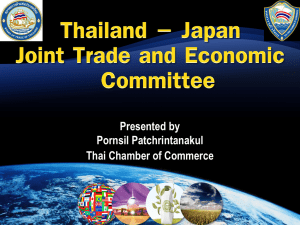Current Topics on Kra-Canal Project in Thailand Kiyoshi KATAOKA,
advertisement
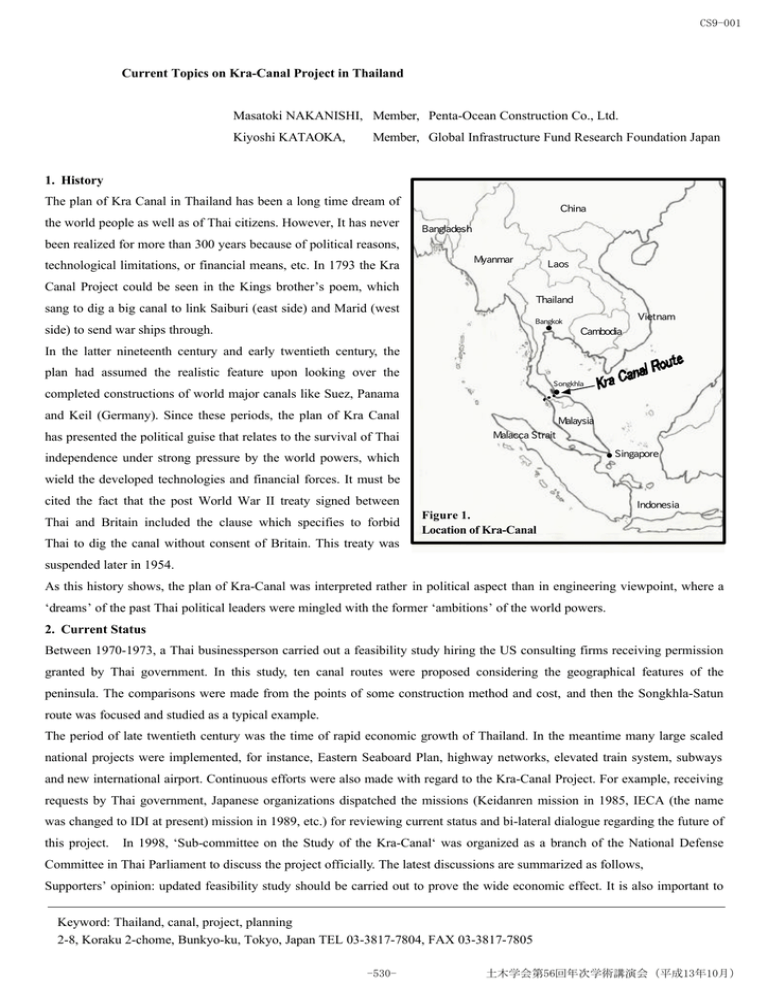
CS9-001 Current Topics on Kra-Canal Project in Thailand Masatoki NAKANISHI, Member, Penta-Ocean Construction Co., Ltd. Kiyoshi KATAOKA, Member, Global Infrastructure Fund Research Foundation Japan 1. History The plan of Kra Canal in Thailand has been a long time dream of the world people as well as of Thai citizens. However, It has never China Bangladesh been realized for more than 300 years because of political reasons, technological limitations, or financial means, etc. In 1793 the Kra Myanmar Laos Canal Project could be seen in the Kings brother’s poem, which Thailand sang to dig a big canal to link Saiburi (east side) and Marid (west Vietnam Bangkok side) to send war ships through. Cambodia In the latter nineteenth century and early twentieth century, the plan had assumed the realistic feature upon looking over the Songkhla completed constructions of world major canals like Suez, Panama and Keil (Germany). Since these periods, the plan of Kra Canal has presented the political guise that relates to the survival of Thai Malaysia Malacca Strait Singapore independence under strong pressure by the world powers, which wield the developed technologies and financial forces. It must be cited the fact that the post World War II treaty signed between Thai and Britain included the clause which specifies to forbid Indonesia Figure 1. Location of Kra-Canal Thai to dig the canal without consent of Britain. This treaty was suspended later in 1954. As this history shows, the plan of Kra-Canal was interpreted rather in political aspect than in engineering viewpoint, where a ‘dreams’ of the past Thai political leaders were mingled with the former ‘ambitions’ of the world powers. 2. Current Status Between 1970-1973, a Thai businessperson carried out a feasibility study hiring the US consulting firms receiving permission granted by Thai government. In this study, ten canal routes were proposed considering the geographical features of the peninsula. The comparisons were made from the points of some construction method and cost, and then the Songkhla-Satun route was focused and studied as a typical example. The period of late twentieth century was the time of rapid economic growth of Thailand. In the meantime many large scaled national projects were implemented, for instance, Eastern Seaboard Plan, highway networks, elevated train system, subways and new international airport. Continuous efforts were also made with regard to the Kra-Canal Project. For example, receiving requests by Thai government, Japanese organizations dispatched the missions (Keidanren mission in 1985, IECA (the name was changed to IDI at present) mission in 1989, etc.) for reviewing current status and bi-lateral dialogue regarding the future of this project. In 1998, ‘Sub-committee on the Study of the Kra-Canal‘ was organized as a branch of the National Defense Committee in Thai Parliament to discuss the project officially. The latest discussions are summarized as follows, Supporters’ opinion: updated feasibility study should be carried out to prove the wide economic effect. It is also important to Keyword: Thailand, canal, project, planning 2-8, Koraku 2-chome, Bunkyo-ku, Tokyo, Japan TEL 03-3817-7804, FAX 03-3817-7805 -530- 土木学会第56回年次学術講演会(平成13年10月) CS9-001 consider the multiplier effect, inter/intra regional trade in Asia, and deterrence for maritime disaster through the Malacca Strait. Objection: National security issue due to separation of land by digging canal, environment issue, and financial issue, etc. should be considered 3. Japan’s Collaboration The newest events attracting people’s attention in Thailand about the project are the activities of the Thai official study team authorized by the Parliament in collaboration with GIF (Global Infrastructure Fund Research Foundation Japan) taking charge in the engineering study. In 1998, GIF organized a team to study the project, receiving request by the Thai Parliament Committee. The point of the engineering study was to review the past 1973’s report and renew it from the viewpoints of stateof-the-art, economic conditions, and shipping market. The study contains the following points. a) Based on the 1973’s study, the most well accepted route (Songkhla-Satun) is chosen for this study. b) The design vessel size is assumed 150,000DWT considering the market trend. c) The length of in-land route is estimated at 106km and total excavation volume is calculated at 3.4 billion cu.m. d) The result shows that the total construction cost is estimated as 24 billion US$ with the minimum construction period of seven years. Following this engineering study, the Thai official study team Table 1. Project cost assessment TAMS 1973 GIF 2000 carried out the economic and financial studies. The study PROJECT COST US$ 7 Billion US$ 24 Billion report was submitted to the Thai Parliament in April 2000. Table 2. Thai financial scales and project cost THAILAND 1976 THAILAND 2003 Table 1 and 2 show the comparison between the past and FORECAST present project costs with Thai economic scales. It shows the GDP US$ 18 Billion US$ 150 Billion US$ 3 Billion US$ 70 Billion canal construction seems more affordable after twenty years’ EXPORT COST/GDP 39% 17% Thai economic growth. COST/EXPORT 235% 36% 4. Prospect In order to attain the growth of developing countries with contributing the world economic growth, this kind of big-scaled project should be one of the options. For supporting the project it is vital to obtain the national/international public acceptance. Needless to say, transparency and public accountability shall be kept in all of the project processes. The contents of future feasibility study shall be considered carefully to comply with such requirement. The following studies will be required as the next step: ・ In order to know the more accurate construction cost, more detailed ground conditions and natural conditions should be investigated. ・ Environmental impact shall be paid attention on the feasibility study. For example, eco-system in Songkhla lakes is important, which began to be discussed in the regional society of engineers. ・ The accurate financial study will be required to secure the investment and to call for the source of fund. Collaborative investment among public and private investors may be required for implementation of such big project. ・ The supplemental impacts should be examined in the financial study. For example, port development using land space brought with this project and industrial development with the port, all of which should be reflected onto the financial plan. In January 2001, the Bangkok Post conducted a public opinion poll. The result appeared 70% agreed to start the feasibility study. Actually detailed feasibility study should be important to answer the people’s voice, which is, we believe the important mission of civil engineers. REFERENCES 1) Bangkok Post Perspective (series of newspaper articles) dated 2nd Jan. 2001 and 13th February 2001, etc. 2) Web site : http.//www.kracanal.or.th -531- 土木学会第56回年次学術講演会(平成13年10月)

